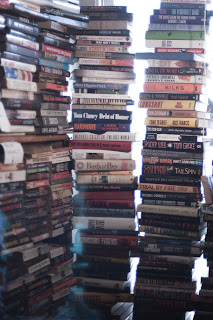In this case, I had a thought bubble up about explaining the size of one's library to guests when they ask "So, you've read all of these?" What a silly question. It's usually posed by someone who has no library of their own, no understanding of the value of such a collection as insurance against dullness and the possibility of suddenly finding oneself with nothing to read. Sure, I have read a large number of the books on my shelves, and I keep them around as reminders of good times, comforting me with the knowledge that I absorbed something from each of them, and can easily open them up again as I please.
It's this last point that is relevant here. The book in question turned out to be A Passion for Books, appropriately enough. I brought this somewhat large paperback along on a solo bike trip last summer under the assumption that I would have time and energy left for reading after biking 60 miles a day. I did not. Nonetheless, I got through a couple of the essays and whatnot while in various B&Bs and the memory link stuck. The book, my friend, had traveled with me and formed that particular synaptical [sic!] connection while in the middle of strange lands (Western Maryland, you know) and unfamiliar furnishings.
Here now are the three passages by assorted authors from the Passion for Books collection which each mention (independently!) the arduous task of explaining one's library to unsuspecting visitors:
In the gradual growth of every student's library, he may – or may not – continue to admit literary friends and advisers; but he will be sure, sooner or later, to send for a man with a tool-chest. Sooner or later, every nook and corner will be filled with books, every window will be more or less darkened, and added shelves must be devised. He may find it hard to achieve just the arrangement he wants, but he will find it hardest of all to meet squarely that inevitable inquiry of the puzzled carpenter as he looks about him. "Have you really read all these books?" The expected answer is, "To be sure, how can you doubt it?" Yet if you asked him in turn, "Have you actually used every tool in your tool-chest?" you would very likely be told, "Not one half as yet, at least this season; I have the others by me, to use as I need them." Now if this reply can be fairly made in a simple, well-defined, distinctly limited occupation like that of a joiner, how much more inevitable it is in a pursuit which covers the whole range of thought and all the facts in the universe. The library is the author's tool-chest. He must at least learn, as he grows older, to take what he wants and to leave the rest.Books Unread by Thomas Wentworth Higginson (what a name)
In the two years I had been coming there, maybe two or three hundred days spent in that apartment from morning till night, I never saw anyone else there – no visitor, no delivery person, no handyman – no one. I asked Chaim about this on one of our walks (I later understood that great Yiddish writers simply do not have or permit visitors; then again, maybe it was the threat of coffee that kept everyone away), and he said something about not wanting people to think him strange for having too many books. I thought he was talking about the annoying line all book collectors endure: Have you read all of these books? I told him about Dr. Johnson's stock response: Yes, and some of them twice! Chaim stopped walking and looked at me disdainfully. "If anyone asks you if you've read all those books," he said, "it means you don't have enough books."They Don't Call It a Mania for Nothing by Harold Rabinowitz (also the editor of Passion)
About the time of the discovery of America a book came out called The Ship of Fools, by one Sebastian Brant. In it was an attack on the book fool: a satire on the passion of collecting, in which the author said that the possession of books was but a poor substitute for learning. That phrase which the layman reader asks the book collector so often with a smirk of condescension, "So you really read them?" undoubtedly originated then. The real book collector, with suppressed murder in his heart, smiles acquiescence, assuming an apologetic air for his peculiar little hobby. His invisible armor is his knowledge, and he has been called a fool so often he glories in it. He can afford to have his little joke. So much for this threadbare gibe.Talking of Old Books by A.S.W. Rosenbach (perhaps the most successful modern book collector of them all)






